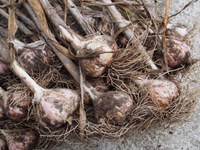Dakota Gardener: Growing Garlic in North Dakota
(Click an image below to view a high-resolution image that can be downloaded)
By Tom Kalb, Horticulturist
NDSU Extension
Frost came early this year - much too early for most of us.
After a hard frost, our natural tendency may be to put our gardens to bed.
But wait a second. We still have a few things we can plant now, including garlic. A little effort now can lead to amazing flavors in your meals next summer.
Fall is the season to plant garlic. Garlic is easy to grow, and home-grown garlic is crisp and zesty. Get your bulbs now before they are all gone. Demand for bulbs is high this fall, and shipping delays may occur due to the COVID crisis.
Garlic types include hardneck, softneck and elephant. Hardneck types are hardiest and most suitable for us in North Dakota.
‘Music’ is the most popular variety in the north. This selection from Canada is hardy and very productive. ‘Music’ cloves are huge and flavorful, and store very well.
Garlic is cherished around the world, and many cultures have developed their own favorite varieties. Go online and you can find hardneck varieties from countries throughout northern Europe and Asia. Your local garden center is another good place to find bulbs.
Some varieties taste mild while others have bold flavors. Some varieties are prized for baking, while others are famous for roasting or frying. The cloves come in shades of white and purple, many with bright stripes.
Garlic is planted soon after the first hard frost, which is usually in late September or early October.
The cloves grow best in a rich, well-drained soil. Add an inch of compost to the site and 2 to 3 pounds of 10-10-10 fertilizer per 100 square feet. Work this into the soil.
Separate cloves from the bulbs a day before planting. Set cloves upright in the furrow, pointed end up, 4 to 6 inches apart and 2 inches deep. Space rows 18 to 30 inches apart.
Irrigate deeply to activate the cloves. The cloves will push out roots and shoots this fall. Mulch with 4 inches of straw or hay. This mulch will insulate the soil and protect the sprouted bulbs during the winter.
The sprouts will grow vigorously next spring and grow up to 3 feet tall. Harvest the flower buds (scapes) when they curl in June. Scapes are mild in flavor and taste great in stir fries. Harvest the bulbs in July when the lower leaves turn brown.
The gardening season is not over. Plant garlic this fall, and you will be rewarded with fresh, zesty flavors in your meals next year.
For more information about gardening, contact your local NDSU Extension agent. Find the Extension office for your county at https://www.ag.ndsu.edu/extension/directory/counties.
NDSU Agriculture Communication - Sept. 29, 2020
Source: Tom Kalb, 701-328-9722, tom.kalb@ndsu.edu
Editor: Ellen Crawford, 701-231-5391, ellen.crawford@ndsu.edu




